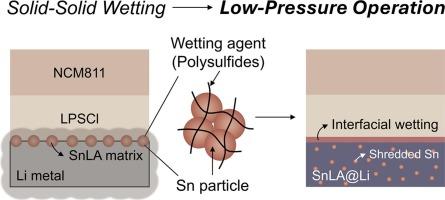Polysulfide-mediated solid-state wetting for low-pressure all-solid-state lithium metal batteries
IF 13.2
1区 工程技术
Q1 ENGINEERING, CHEMICAL
引用次数: 0
Abstract
The quest for practical all-solid-state lithium metal batteries (ASSLMBs) has focused on achieving reliable operation at room temperature and low stack pressure. However, attempts to lower this pressure have proved challenging due to interfacial instabilities and unwanted lithium (Li) dendritic growth. Here, we introduce a solid-state wetting approach of the Li metal anode by utilizing a polysulfide derived from α-lipoic acid (LA) and lithiophilic tin (Sn) seeds. The polymeric network constructs strong interfacial bridges between the Li metal and solid electrolyte, while simultaneously driving the depth-wise redistribution of the pulverized Sn seeds throughout the bulk Li metal, thereby achieving comprehensive solid-state wetting that extends across the anode structure. This architecture, by concurrently mitigating the interfacial and bulk instabilities in Li0.97Mg0.03 metal anodes, enables stable operation at room temperature and low stack pressure (2.5 MPa), along with exceptional capacity retention of 86.7 % over 160 cycles at 0.5C with a high areal capacity of 3.5 mAh cm−2. This study establishes foundational guidelines for the design of Li metal anodes toward high-performance ASSLMBs under practical operating conditions.

低压全固态锂金属电池用多硫化物介导固态润湿
对实用的全固态锂金属电池(asslmb)的追求一直集中在实现在室温和低堆压下的可靠运行。然而,由于界面不稳定和不必要的锂(Li)枝晶生长,降低该压力的尝试具有挑战性。本文采用α-硫辛酸(LA)和亲锂锡(Sn)衍生的多硫化物作为锂金属阳极的固态润湿方法。聚合物网络在锂金属和固体电解质之间构建了强大的界面桥,同时推动了Sn颗粒在大块锂金属中的深度再分布,从而实现了横跨阳极结构的全面固态润湿。该结构同时减轻了Li0.97Mg0.03金属阳极的界面和体不稳定性,能够在室温和低堆叠压力(2.5 MPa)下稳定运行,并且在0.5C下,在160 次循环中具有86.7 %的优异容量保持,具有3.5 mAh cm - 2的高面积容量。本研究为在实际操作条件下设计高性能asslmb的锂金属阳极建立了基础指南。
本文章由计算机程序翻译,如有差异,请以英文原文为准。
求助全文
约1分钟内获得全文
求助全文
来源期刊

Chemical Engineering Journal
工程技术-工程:化工
CiteScore
21.70
自引率
9.30%
发文量
6781
审稿时长
2.4 months
期刊介绍:
The Chemical Engineering Journal is an international research journal that invites contributions of original and novel fundamental research. It aims to provide an international platform for presenting original fundamental research, interpretative reviews, and discussions on new developments in chemical engineering. The journal welcomes papers that describe novel theory and its practical application, as well as those that demonstrate the transfer of techniques from other disciplines. It also welcomes reports on carefully conducted experimental work that is soundly interpreted. The main focus of the journal is on original and rigorous research results that have broad significance. The Catalysis section within the Chemical Engineering Journal focuses specifically on Experimental and Theoretical studies in the fields of heterogeneous catalysis, molecular catalysis, and biocatalysis. These studies have industrial impact on various sectors such as chemicals, energy, materials, foods, healthcare, and environmental protection.
 求助内容:
求助内容: 应助结果提醒方式:
应助结果提醒方式:


